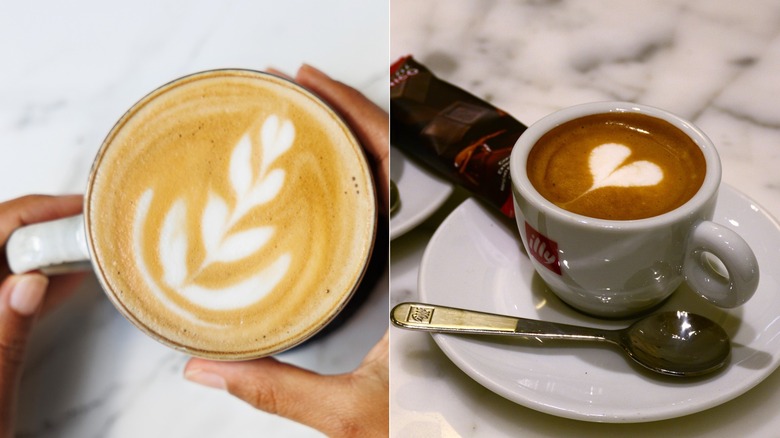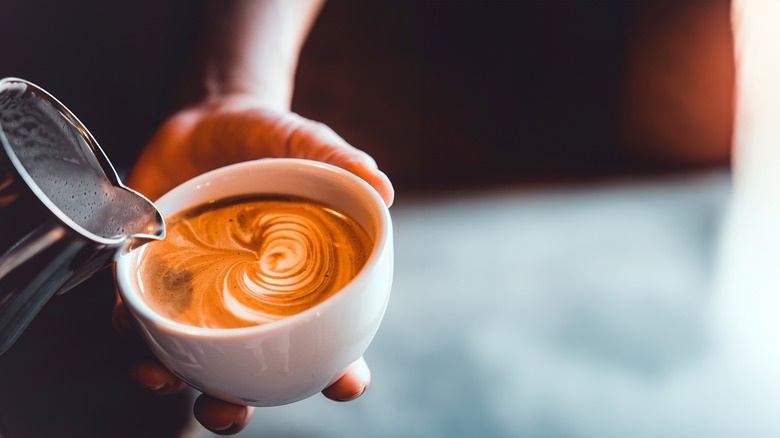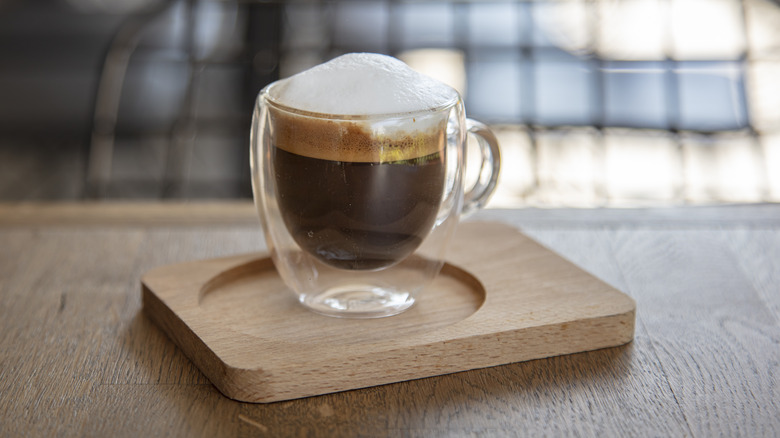What's The Difference Between Macchiato And A Latte?
If you're the kind of person who just orders a regular old coffee, or if you just prefer it filter style — where you add your own milk, cream, or sugar — you're probably not aware of the difference between different types of espresso drinks. Two such drinks are the macchiato and the latte; there are several more, like cappuccinos and americanos, and, thanks to Australia and New Zealand, the increasingly-popular flat white (and there are iced varieties of most of these drinks) — but these are covered in other articles.
Both the macchiato and latte start with a base of espresso and feature some amount of steamed or frothed milk added to that. The main difference is the amount of milk that's added — more on that in a moment, but lattes generally have a lot more milk. The two are different sizes, which therefore means different cups for them, too. But when it comes to the macchiato, pay attention: Thanks to Starbucks and its popularization of drinks like the caramel macchiato, the exact meaning of "macchiato" has been muddied, departing from its Italian origins to refer to something else. Here, we'll focus more on the traditional Italian version, but with some details on how it differs from chain coffee shops' wildly different take on it.
What is a latte?
In Italian, "latte" means "milk," and that's what you'll get with this coffee drink. Technically, the Italian coffee drink is called a "caffè latte" — if you go to Italy and order just a "latte," you may receive a glass of milk. However, in the U.S., the term latte should get you a drink with actual coffee in it.
Generally speaking, a latte is a pretty milky coffee drink, with a ratio of one-third espresso to two-thirds steamed milk. It's usually about 8 ounces (240 mL) in total, so that means it would be made with a double shot of espresso. A single shot is around 1 to 1.5 ounces, but exact sizes can vary a little bit. Bear in mind that many coffee shops offer different sized drinks, and larger lattes can easily go over 10 ounces, so depending on the volume of coffee in a café's shots, the exact ratios can vary. But generally speaking, expect that coffee to be fairly well-diluted with milk. A latte is usually topped with a thin layer of foam (sometimes called microfoam) — about 0.5 centimeters, or one-fifth of an inch. This makes it less foamy than a cappuccino, which has a centimeter of foam on top. That milk foam may be carefully poured by a barista to form shapes like a heart (called "latte art") although this isn't a requirement. They're usually served in a larger coffee cup, although some countries (like Australia) serve lattes in glasses.
What is a macchiato?
Also coming from Italian, "macchiato" means something like "stained." As a drink, this refers to the fact that the espresso is "stained" with a small amount of milk. In practice, this means a macchiato is a shot or two of espresso topped with just a splash of steamed milk or foam. The exact amount of milk can be debated: Some sources suggest just a spoonful of foam dabbed on top of the coffee, others suggest a milkier ratio of two parts coffee to one part milk. But either way, you'll get a far stronger coffee taste than a much milkier drink like a latte. As a small drink, it usually comes in an espresso cup.
But, as mentioned, the term "macchiato" has gotten a bit complicated. For one, there's the latte macchiato, which reverses the equation, giving you hot milk that's "stained" with a shot of espresso (the ratio is about 3-to-1); giving an end product that's closer to a latte or cappuccino. And then there's the Starbucks universe of macchiatos, with flavors like apple crisp and caramel. These are closer to latte macchiatos, in that they're milk-heavy and "stained" with espresso but with extra syrups added, making some baristas consider them more like a dessert. Such drinks have become popular enough that the lines between espresso macchiatos and these sweet drinks have gotten blurred — so if you're unsure about a cafe menu's "macchiato," just ask before ordering.


